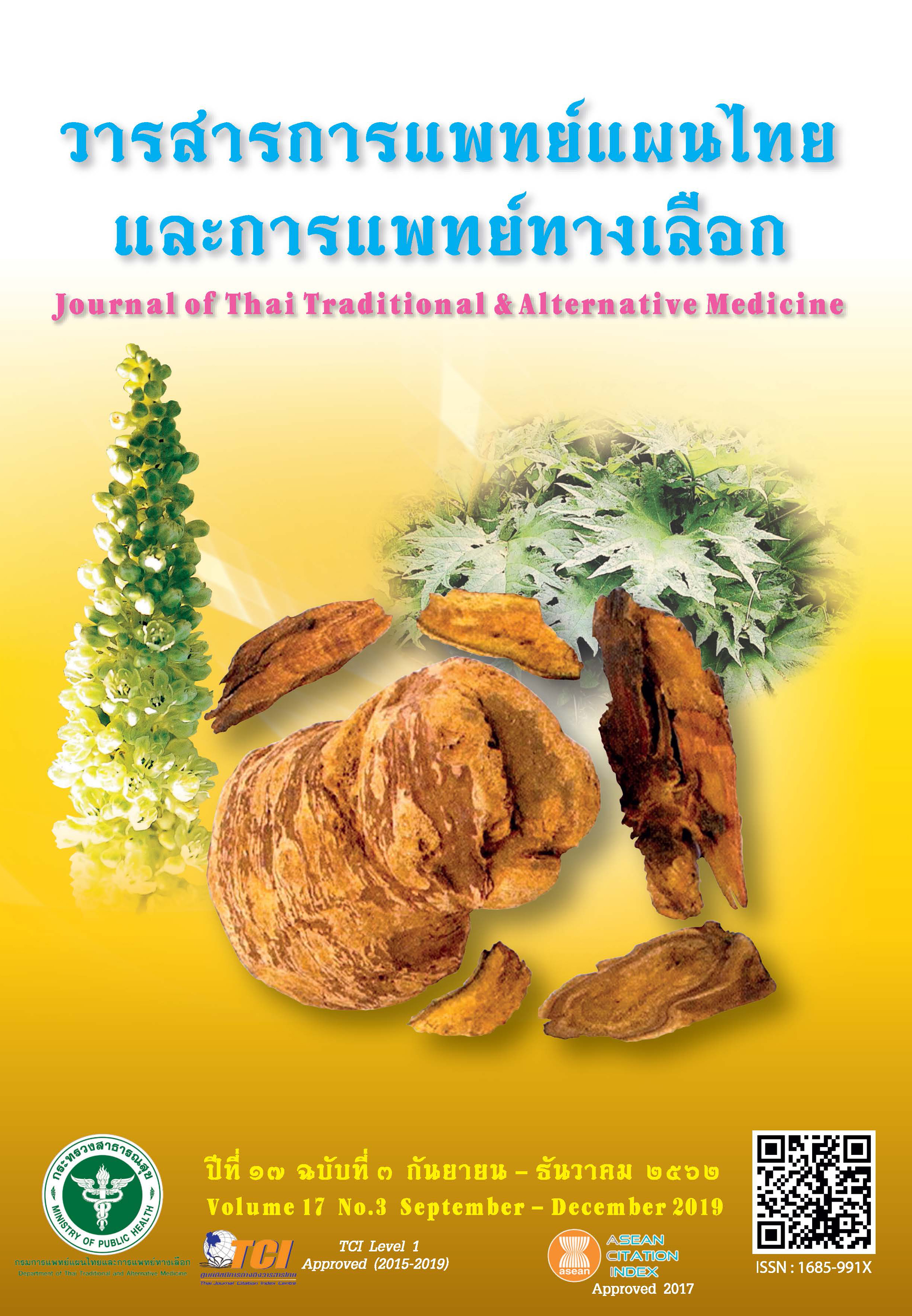ประสิทธิผลเบื้องต้นของยาทาพระเส้นเพื่อลดอาการปวดเข่า ของผู้ป่วยโรคลมจับโปงแห้งเข่าทางการแพทย์แผนไทย
Main Article Content
บทคัดย่อ
งานวิจัยนี้มีวัตถุประสงค์เพื่อศึกษาประสิทธิผลเบื้องต้นของยาทาพระเส้นในการบรรเทาอาการปวดเข่าจากโรคลมจับโปงแห้งเข่าทางการแพทย์แผนไทย เป็นการศึกษาผู้เข้าร่วมวิจัยที่มีอาการปวดเข่า โดยการวินิจฉัยของแพทย์แผนไทยประยุกต์ ว่าเป็นโรคจับโปงแห้งเข่า ที่มารับบริการที่โรงพยาบาลส่งเสริมสุขภาพตำบลบ้านเหล่าสามัคคี ตำบลพระเจ้า อำเภอเชียงขวัญ จังหวัดร้อยเอ็ด จำนวน 50 คน โดยสุ่มแบบ randomized double-blinded controlled trial แบ่งกลุ่มออกเป็น 2 กลุ่ม กลุ่มละ 25 คนเท่ากัน กลุ่มที่ 1 เป็นผู้ที่ได้รับยาทาพระเส้น กลุ่มที่ 2 เป็นผู้ที่ได้รับยาหลอก โดยให้ผู้เข้าร่วมวิจัยทายาบริเวณเข่า วันละ 3 ครั้ง เวลาเช้า กลางวัน และก่อนนอน ติดต่อกันเป็นเวลา 7 วัน ประเมินผลก่อนและหลังการใช้ยาด้วยแบบสอบถามและแบบบันทึกข้อมูลใช้สถิติ ร้อยละ ค่าเฉลี่ย และส่วนเบี่ยงเบนมาตรฐาน การวิเคราะห์ข้อมูลแบบประเมินระดับความเจ็บปวด Visual Analog Scale (VAS) แบบประเมินอาการโรคข้อเข่าเสื่อม Western Ontario and McMaster University (WOMAC) เครื่องมือวัดองศาการเคลื่อนไหวของข้อเข่า โกนิโอมิเตอร์ (goniometer) ใช้ paired sample t-test และการเปรียบเทียบหลังการรักษาระหว่างกลุ่มใช้ independent sample t-test ผลการศึกษา พบว่า กลุ่มผู้เข้าร่วมวิจัยเป็นเพศหญิง จำนวน 33 คน (ร้อยละ 66.0) มีช่วงอายุ 60-69 ปี จำนวน 14 คน (ร้อยละ 28.0) ข้อมูลกลุ่มที่ 1 ระดับความปวดข้อเข่าลดลง ระดับอาการข้อเข่าฝืดลดลง ระดับความสามารถในการใช้งานข้อเข่าดีขึ้น และองศาการเคลื่อนไหวของข้อเข่าดีขึ้น ซึ่งแตกต่างกันอย่างมีนัยสำคัญทางสถิติ (p < 0.05) ส่วนกลุ่มที่ 2 ระดับความปวดข้อเข่าเพิ่มขึ้น ระดับอาการข้อเข่าฝืดเพิ่มขึ้น ระดับความสามารถในการใช้งานข้อเข่าลดลงและองศาการเคลื่อนไหวของข้อเข่าลดลง ซึ่งไม่มีความแตกต่างกันอย่างมีนัยสำคัญทางสถิติ (p > 0.05) เมื่อเปรียบเทียบระดับความปวด ระดับอาการข้อเข่าฝืด ระดับความสามารถในการใช้งานข้อเข่า และองศาการเคลื่อนไหวของเข่า หลังได้รับยาระหว่างกลุ่ม พบว่ามีความแตกต่างกันอย่างนัยสำคัญทางสถิติ (p < 0.05) ดังนั้นยาทาพระเส้นในตำรับโอสถพระนารายณ์มีประสิทธิผลเบื้องต้นในการลดอาการปวดเข่า ลดอาการข้อเข่าฝืด ทำให้ความสามารถในการใช้งานของข้อเข่าดีขึ้น และองศาการเคลื่อนไหวของข้อเข่าดีขึ้น
Article Details
เอกสารอ้างอิง
2. The Royal College of Orthopaedic Surgeons of Thailand. Bangkok: Guideline for the Treatment of Osteoarthritis of Knee 2011; 2011. (in Thai)
3. Suwannatrai S, Punpeng T, Khumkaew N, Khumkaew P, Seeloopmork P, Udomkiat P, Chotivichit A, Akarasereenont P, Laohapand T. Comparison of the diagnosis of osteoarthritis knee by western medicine standard with the Thai traditional medicine diagnosis of Lom-Jub-Pong-Hang-Kao. Siriraj Med Bull. 2018;11(2):88-95. (in Thai)
4. Center of Applied Thai Traditional Medicine. Thai therapeutic massage (court type Thai traditional massage). Bangkok: Suphawanich publishing; 2005. 190 p. (in Thai)
5. Pichiansuntorn C, Chavalit M, Jerawong V. Explanation of King Narai’s textbook of Medicine (Tamra Phra Osoth Phra Narai). 3rd ed. Bangkok: Amarin printing and publishing; 2015. 778 p. (in Thai)
6. Winitchai S, Vutdhiipapornkul P. Asukovit P. Antiinflammatory, toxicity and antioxidant activity of herbal extracts of Tha Pra Sen Osoth Phra Narai and the development of herbal cream products. Journal of Thai Traditional and Alternative Medicine. 2016;14(2):72. (in Thai)
7. Kuptniratsaikul V, Rattanachaiyanont M. Validation of a modified Thai version of the Western Ontario and McMaster (WOMAC) osteoarthritis index for knee osteoarthritis. Clin Rheumatol. 2007;26(10):1641-5.
8. Bellamy N. The WOMAC knee and hip osteoarthritis indices: development, validation, globalization and influence on the development of the AUSCAN hand osteoarthritis indices. Clin Exp Rheumatol. 2005;23(5 Suppl 39):S148-53.
9. Bang JS, Oh DH, Choi HM, Sur BJ, Lim SJ, Kim JY, Yang HI, Yoo MC, Hahm DH, Kim KS. Anti-inflammatory and antiarthritic effects of piperine in human interleukin 1β-stimulated fibroblast-like synoviocytes and in rat arthritis models. Arthritis Res Ther. 2009;11(2):R49. doi:10.1186/ar2662. PubMed PMID: 19327174


